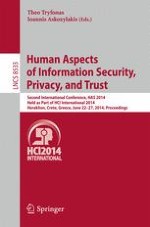This book constitutes the proceedings of the Second International Conference on Human Aspects of Information Security, Privacy, and Trust, HAS 2014, held as part of HCI International 2014 which took place in Heraklion, Crete, Greece, in June 2014 and incorporated 14 conferences which similar thematic areas. HCII 2014 received a total of 4766 submissions, of which 1476 papers and 220 posters were accepted for publication after a careful reviewing process. These papers address the latest research and development efforts and highlight the human aspects of design and use of computing systems. The papers thoroughly cover the entire field of Human-Computer Interaction, addressing major advances in knowledge and effective use of computers in a variety of application areas. The 38 papers presented in the HAS 2014 proceedings are organized in topical sections named: usable security; authentication and passwords; security policy and awareness; human behaviour in cyber security and privacy issues.
